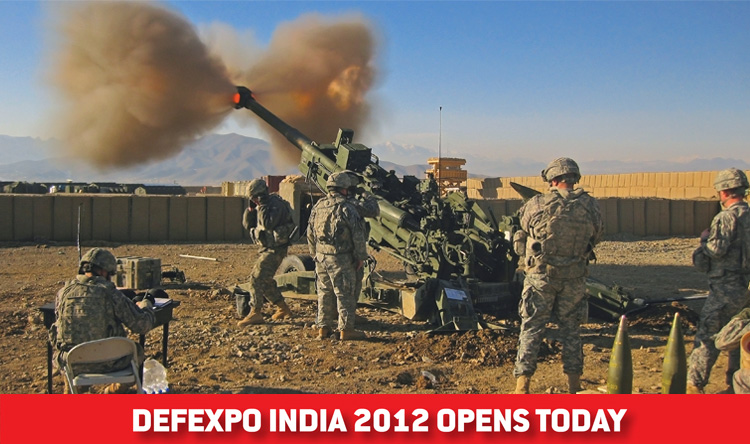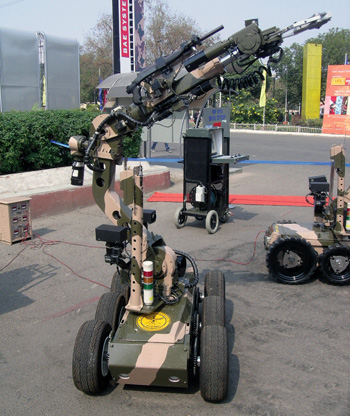- Prime Minister Narendra Modi inaugurates Aero India 2023 in Bengaluru; Releases Commemorative Stamp
- Defence Secretary meets delegations from Saudi Arabia, USA and Oman on the sidelines of Aero India 2023
- Foreign Ministers of 32 countries to attend Aero India 2023
- Embraer showcases the C-390 Millennium at Aero India 2023
Asia's biggest land and maritime show is here

It's official. With an economy that is growing steadily even within a global slowdown and an ever intensifying spectrum of threats, India is now by far the world's most attractive market for military equipment and advanced systems. Two recent events have ensured that India's place at the pinnacle of the global market for armed forces and paramilitary hardware is safe. Earlier this month, amid speculation that the country's national defence budget might actually be slashed, it saw a healthy 17 per cent jump to over $38 billion, with a formidable $15.5 billion war chest for fresh and ongoing acquisitions. Second, India is now the world's largest importer of weapons, a status that will now see a country that has traditionally imported hardware, enter a realm of dynamic partnerships, cross-investment and synergies with global technology houses. The India of yore, a buyer rather than a partner, is now a brave new nation with compelling indigenous capabilities and the will to perform on a competitive global stage. In many ways, the seventh Defexpo India 2012 comes at profound time for Indian security.
The seventh international exhibition on land, naval and internal security systems that begins today is the largest ever defence exposition in Asia allowing companies from across the world to once again come together in what is, without a doubt, every defence firm's priority dream market. It is a chance, once again, to showcase India’s emergence as an attractive destination for investment in defence and provides the best possible platform for alliances and joint ventures in the industry. In fact, things kick off right from the start. To engage industry in a discussion to review existing policies related to defence procurement, the Ministry of Defence and FICCI are organising a half-day seminar on “Enhancing Defence Production Capability through DPP” today.
Nobody says no to Defexpo. An impressive 567 companies from 32 countries will be here for the next four days to showcase weapons, munitions, specialty vehicles and advanced maritime systems for the Army, Navy and paramilitary. The major exhibiting countries participating in the seventh edition of the expo include Russia, the United States, France, United Kingdom Israel, Belgium, Germany, Italy, Japan and the Republic of Korea. Israel is the biggest participating country in terms of indoor space occupied (1,293 sq metres) while Russia is represented with the maximum number of 37 companies. In the year 2010, there were 412 exhibitors from 35 countries. The exhibition area has increased from 27,309 sq metres in 2010 to 30,760 sq metres this year. Defexpo is dedicated to global land, naval and internal security business activity, providing a seamless platform for suppliers, manufacturers, technology providers to service providers. The expo is also a brilliant oasis of global capabilities in the region- a fact reflected in the 60 official foreign delegations (14 of those headed by Defence Ministers) that will attend the four-day exhibition in an effort to assess systems and make enquiries. So if India wasn't an attractive enough market, the region is coming calling.

In an evolution of sorts, Defexpo 2012 will be a proving ground for India's burgeoning private sector that has received its calling to pitch in for national security. With gradually evolving policies that will, hopefully in the near future, provide a competitive playing field for healthy competition, India's robust private sector is looking actively for investments and technology partnerships with proven firms. India's expansive state-owned military industrial complex, which holds most keys to self-reliance, have now been imbued with the freedom to improvise, invite foreign technology and make full use of the capabilities on offer to India, a responsible and peaceful democracy. The public-private partnership model, while still in evolution, could reasonably be joined by dynamic public-privateforeign business models, harnessing the indispensable strengths of each. Each passing Defexpo has proven when it comes down to the empirical post-show bean count, that businesses big and small profit from being here.
With great attention being paid to India's aerospace contracting (Defexpo, inevitably, has its own aerospace component, and a significant one at that), almost wholly represented in recent years by the monumental multi-billion medium multi-role combat aircraft (MMRCA) competition, India's land and maritime systems needs are no less dramatic. The Indian Army, in the midst of a deep doctrinal transformation that could change the very core of how it fights its wars, is a tough customer looking to overhaul many of its legacy systems-from specialty vehicles to infantry weapons, and from battlefield electronics to unmanned systems. The Army's future infantry soldier as a system (F-INSAS) alone provides an evolving opportunity for firms worldwide to partner with Indian industry to kit up one of the world’s largest and most potent land forces.
The Indian Navy, a vanguard for indigenisation, is in the process of floating its next big procurement effort-the Project 75 India submarine project, that looks to build six conventional attack submarines within the country in tandem with the six DCNS Scorpenes currently being built in Mumbai. With Indian state-owned shipyards spilling over with warship orders, and the Indian private sector pitching in admirably, there are substantial opportunities for new surface combatants, support and specialty vessels. The Navy, which inspires several other regional maritime forces and the way they contract in turn, is also looking to overhaul its backbone communications infrastructure, network-centric systems, shore-based and ship-borne sensors and weapons.
India's nascent offsets regime is now in full force, with ambitious guidelines that will see billions of dollars worth of contracting money diverted back into the country in the form of direct (defence) offsets and indirect (civil aerospace, internal security, and training) offsets. The offsets policy is evolving quickly. For instance, in November 2011, Tier-I sub-vendors were allowed to discharge offset obligations to the extent of their work share (by value) on behalf of the main/prime vendor. This and other course corrections will ensure that offsets don't seem like the monumental challenge they appeared to be about two years ago. As the Defence Minister said in the Parliament this month, "These amendments provide greater flexibility and a wider range of offset opportunities to vendors participating in defence procurements and will encourage building up of indigenous manufacturing capability in crucial areas." Apart from high profile business activity, Defexpo 2012 provides a timely and valuable platform for Indian and foreign firms to hammer out partnerships that help fulfil offset requirements. Several companies have already begun the process. Several more will engage.
In the bustle of national defence, it is easy to gloss over internal security and the enormous opportunities for synergies that exist there. From tactical unmanned systems and deep penetration sensors, to side-shot weapons and traditional small arms, the Indian police forces and paramilitary continue to require multiple modern capabilities to take on newer and more challenging tasks. With profiles changing and the commitment of internal security forces towards internal insurgencies in Central India, requirements specific to the new profile have emerged. Special protective gear, humanitarian relief equipment and survival aids will be required in substantial quantities across the armed forces and paramilitary. Those requirements will be enunciated over the four days of Defexpo 2012.
Enjoy the show!





